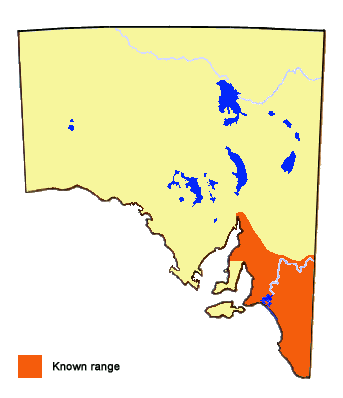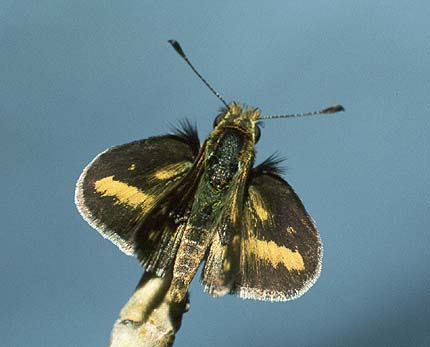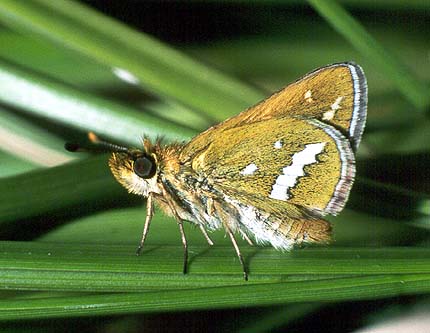-
Larval Food Host
-
Native and introduced grasses including
*Agrostis capillaris (brown-top bent),
Rytidosperma spp incl. R. caespitosa (common wallaby-grass),
Austrostipa scabra (rough spear-grass),
*Cynodon dactylon (couch),
Echinopogon spp (rough-bearded or hedgehog grasses),
*Ehrharta calycina (perennial veldt grass),
*Ehrharta erecta (panic veldt grass),
*E. longiflora (annual veldt grass),
Imperata cylindrica (blady or kunai grass),
Enteropogon acicularis (branching umbrella grass or curly windmill grass),
Microlaena stipoides var. stipoides (meadow rice-grass),
*Paspalum dilatatum (paspalum),
*Pennisetum clandestinum (kikuyu),
Phragmites australis (common reed),
*Piptatherum miliaceum (rice millet),
Poa spp incl. P. labillardieri, P. sieberiana and P. tenera (Poaceae);
also Carex gaudichaudiana (sedge) (Cyperaceae).
The larvae eat the leaves of the hostplant.
-
Eggs
-
Large, domal or hemispherical shaped, base flat circular, pale yellow when newly laid,
but after 2 days if fertile the eggs acquire a ragged pale orange-red lateral ring
and a similarly coloured micropylar area. Eggs turn white near hatching. The small
micropylar area on top of the egg is depressed, the upper part of the egg surface
has a very fine indistinct raised polygonal pattern, while the lower part has
indistinct, very fine vertical ridges. The base is rimmed. Laid singly on the leaves
of the hostplant. Eggs start to hatch after 8 days in late summer. The egg shell
is eaten by the larva after its emergence.
-
Larvae
-
The first instar is long cylindrical, initially pale yellow, but turning green
after eating the hostplant. The head is rounded, large, shining black having
a few hairs, and the neck (prothoracic plate) is black. There are a few short
hairs along the body and long recurved hairs occur posteriorly.
After eating the empty eggshell the larva will eat a small portion of the hostplant
to test that it is the correct hostplant, then it will move to near the tips of
the leaves to form a small tubular shelter, which (if it is a broad leaved grass)
it does by folding over a portion of the leaf and joining the edges together by
distinct cross strands of silk causing a zebra-like stitch pattern.
(When the larva joins the two leaf edges together with silk, the silk shrinks on
drying and gradually the two edges are drawn together, although with this skipper
there is always a slight gap between the two edges.)
The young larva eats the edges of the leaf between the end of the shelter and
the leaf tip, leaving behind the central main vein of the leaf. In interstate
areas the larvae have also been reported on wiry leaved grasses and in this
situation the larvae join several leaves together to make a shelter.
The final instar larva is 20-21 mm long, semi-translucent green, long cylindrical
shaped. The head occurs in two colour forms, being either white with vertical brown
markings, or black with vertical white markings.
-
Pupae
-
12-16 mm long.
-
Flight Period in South Australia
-
It flies mainly during the warmer months, from mid September to early May.
There are continuous broods over the warmer months, which can be completed
within 7 weeks in summer. It normally overwinters as larvae,
but sometimes the larvae will pupate to produce the odd flying adults in winter,
particularly in warmer areas. Eggs laid in autumn either produce larvae that rapidly
mature into pupae and adults that fly in late autumn and early winter, or they may
produce larvae that slowly develop over winter to produce adults that fly in spring.

-
Distribution
-
In South Australia the skipper is found in the eastern temperate parts of the
agricultural belt, and tends to be more common in the cool Lower Southeast Region.
It has yet to be found on Eyre Peninsula, Kangaroo Island or southern Yorke Peninsula.
It may have a wider distribution than presently known as the skipper is very small
(smaller than a bee) and is easily overlooked. The nominotypical local subspecies
also occurs in similar habitat in Victoria, Tasmania, NSW, ACT, Qld and also
Lord Howe Island. A very different subspecies of the skipper occurs in southwest
Western Australia.

-
Habitat
-
The skipper is found in areas where its grass hostplants remain in a soft green
condition throughout the year. It is often found along open damp grassy creek
courses, and in irrigation areas. It is fond of swampy areas, particularly in
open green grassy verges next to the wetlands. It is sometimes seen in urban
areas where lawn grass occurs in a rank condition.
-
Conservation Status in South Australia
-
Although broadly distributed, it is only seen sporadically and usually occurs in
very low numbers at any one location, and on that basis is considered to be rare.
-
Threats
-
In the natural environment the main threats are drought and the effects of agricultural
disturbances. In the urban environment, well manicured lawns and gardens will keep skipper
numbers down, as will the use of toxic sprays and herbicides, especially in irrigated areas.
-
Conservation Strategy
-
None required.



